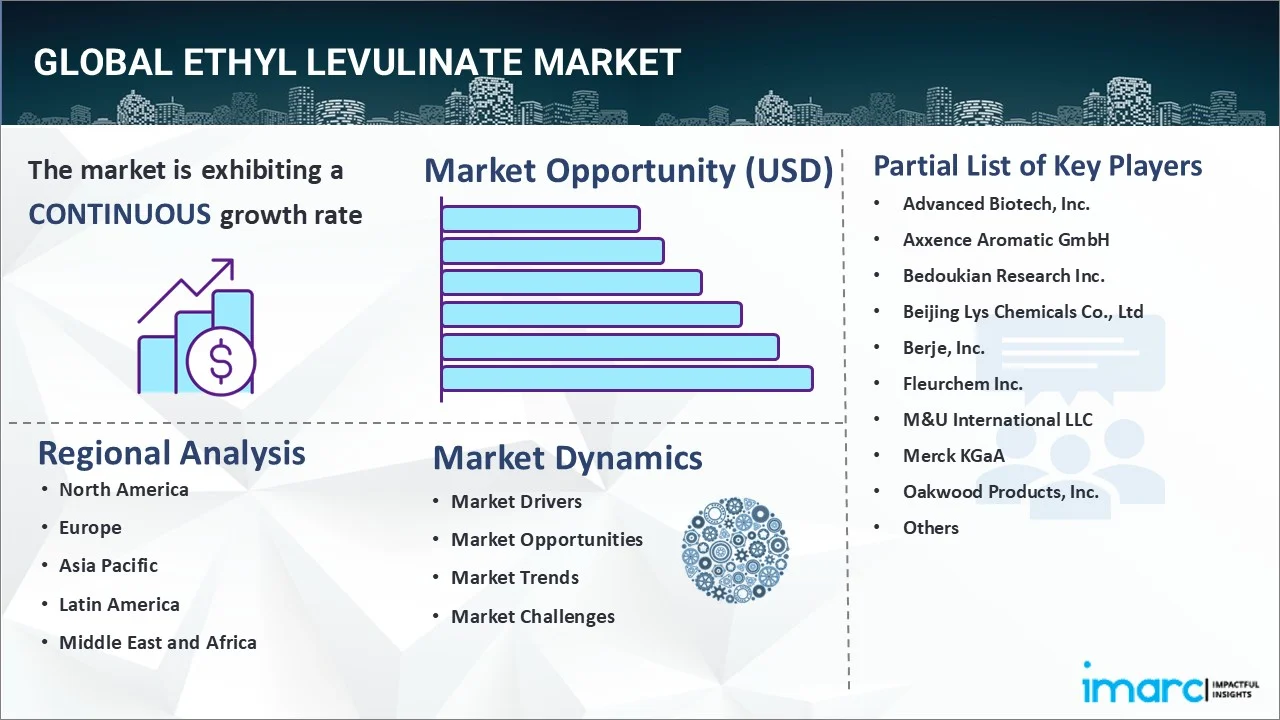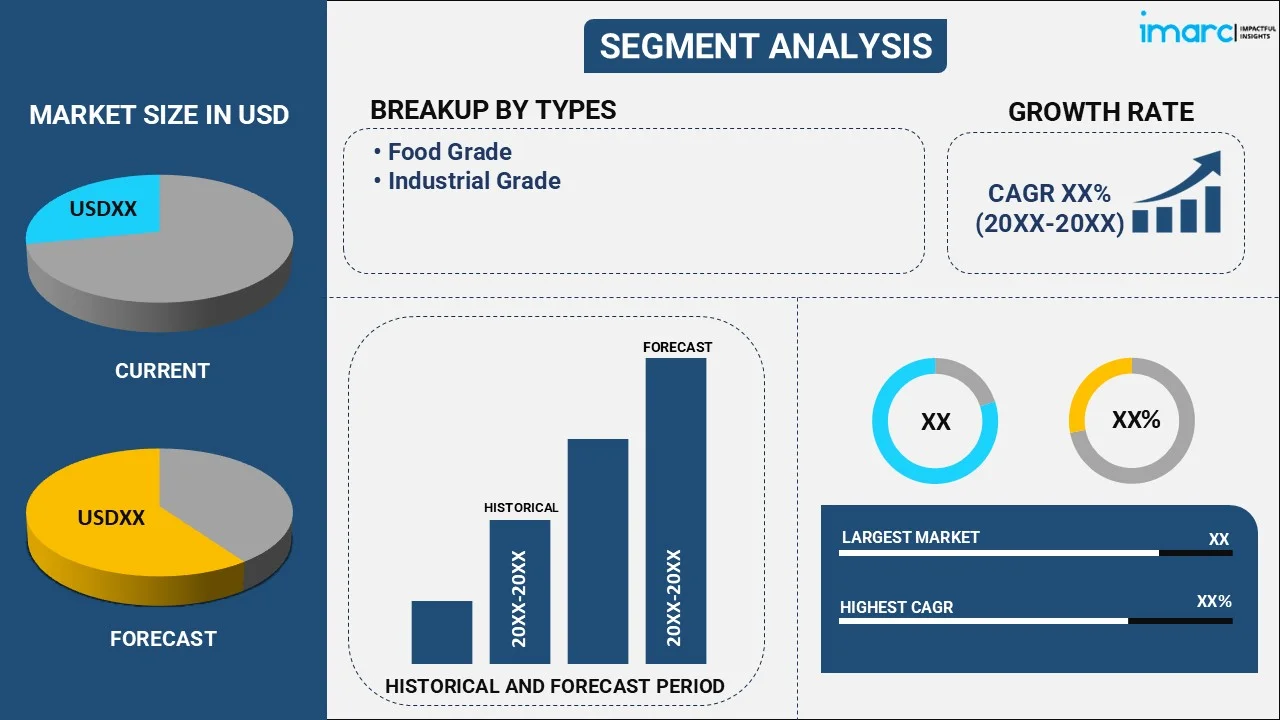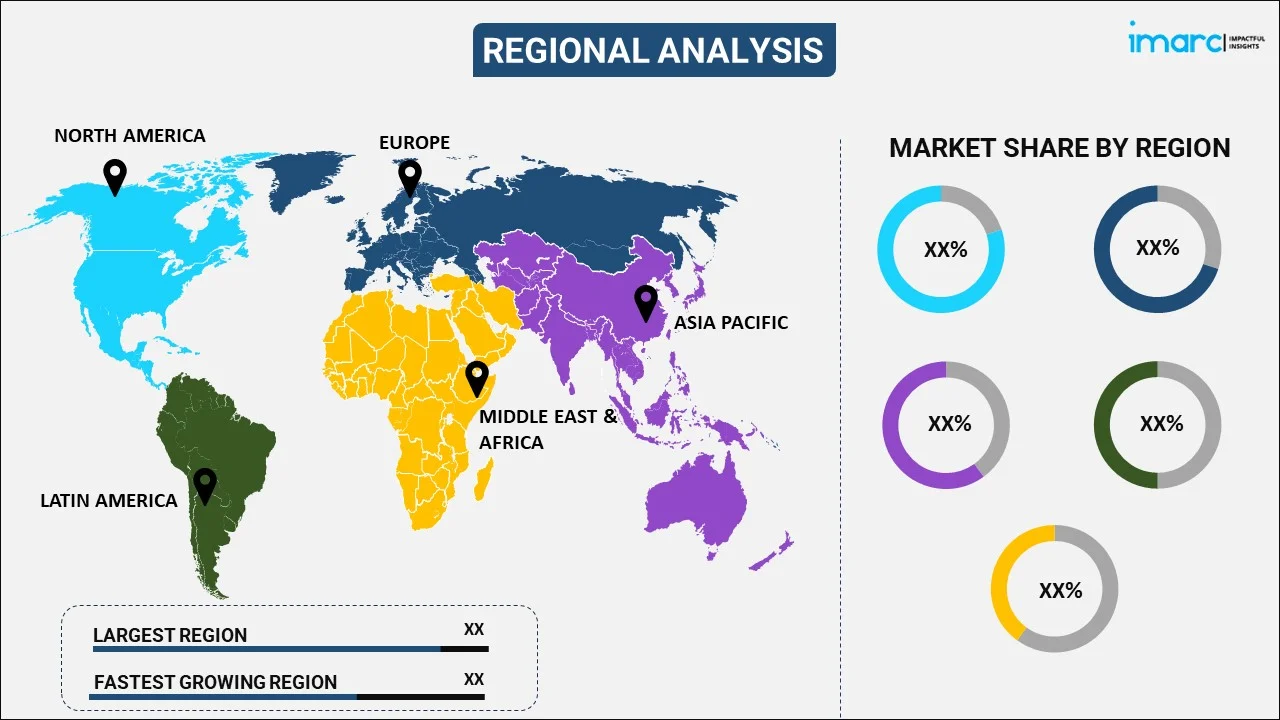
Ethyl Levulinate Market Report by Type (Food Grade, Industrial Grade), Application (Food Additives, Fragrances, Pharmaceutical Intermediates, and Others), and Region 2025-2033
Market Overview:
The global ethyl levulinate market size reached USD 12.1 Million in 2024. Looking forward, IMARC Group expects the market to reach USD 20.1 Million by 2033, exhibiting a growth rate (CAGR) of 5.27% during 2025-2033. The increasing demand for sustainable chemicals, surging awareness regarding the non-toxic and biodegradable properties of the product, and escalating application in renewable energy sectors, biofuels, and additives are some of the factors fueling the market growth.
|
Report Attribute
|
Key Statistics
|
|---|---|
|
Base Year
|
2024 |
|
Forecast Years
|
2025-2033
|
|
Historical Years
|
2019-2024
|
| Market Size in 2024 | USD 12.1 Million |
| Market Forecast in 2033 | USD 20.1 Million |
| Market Growth Rate (2025-2033) | 5.27% |
Ethyl levulinate is a chemical compound derived from renewable sources such as biomass and agricultural waste. It is produced through the esterification of levulinic acid with ethanol, a process that involves combining these components under controlled conditions. Ethyl levulinate finds applications across various industries due to its versatile nature. As a fuel additive, it enhances the combustion efficiency of gasoline and diesel, contributing to reduced emissions. Furthermore, its potential as a solvent in various formulations, such as paints and coatings, highlights its usefulness in industrial processes. Ethyl levulinate is also gaining attention as a flavor and fragrance ingredient in the food and cosmetic sectors. Its advantages lie in its renewable origin, low toxicity, and potential to replace conventional, petroleum-based compounds.

The global ethyl levulinate market is influenced by the growing demand for sustainable and bio-based chemicals in various industries, such as cosmetics, fragrance, and flavor, and increasing consumer awareness and regulatory initiatives promoting eco-friendly solutions. Additionally, the expanding utilization of ethyl levulinate as a potential replacement for traditional solvents due to its low toxicity and biodegradability further propels the market growth. Moreover, the rising interest in renewable energy sources has driven the demand for ethyl levulinate, as it finds applications in biofuels and bio-based additives, which, in turn, is augmenting the market growth. Besides this, the ongoing research and development (R&D) efforts aimed at enhancing the production process and scalability of ethyl levulinate contribute to the market expansion. Furthermore, strategic collaborations and partnerships among manufacturers, researchers, and end-users and advancements in biotechnology are boosting the market growth.
Ethyl Levulinate Market Trends/Drivers:
Growing demand for sustainable solutions
The global ethyl levulinate market is experiencing a significant surge in demand, primarily propelled by the increasing emphasis on sustainable and bio-based chemicals across various industries. Industries such as cosmetics, fragrance, and flavor are witnessing a shift in consumer preferences toward environmentally friendly products. This growing awareness, coupled with stringent regulatory measures promoting eco-friendly solutions, has created a robust market for ethyl levulinate. As a biodegradable compound derived from renewable sources, ethyl levulinate aligns with the sustainability goals of these industries. Its use as a potential replacement for traditional solvents has gained traction due to its low toxicity and environmental friendliness. This trend not only reduces the ecological footprint but also opens avenues for innovative applications, further fueling the market's growth prospects.
Transition to eco-friendly solvents
The global push toward adopting eco-friendly and non-toxic solvents has led to a significant rise in the demand for ethyl levulinate. Industries across the board, from paints and coatings to pharmaceuticals, are seeking alternatives to conventional solvents that often come with environmental and health hazards. Ethyl levulinate, with its remarkable properties of being both biodegradable and low in toxicity, has emerged as a suitable replacement. This transition not only addresses regulatory concerns but also aligns with corporate sustainability initiatives. Manufacturers are increasingly recognizing the value of incorporating ethyl levulinate into their formulations to meet these evolving market demands. As a result, the market for ethyl levulinate is witnessing consistent growth as industries make the strategic shift toward greener solvents.
Adoption of biofuels and renewable energy sources
The global movement toward adopting renewable energy sources has bolstered the demand for bio-based chemicals with diverse applications, including biofuels. Ethyl levulinate, derived from biomass, has gained prominence due to its potential to serve as a key ingredient in biofuels and bio-based additives. As countries strive to reduce carbon emissions and lessen their dependence on fossil fuels, biofuels have emerged as a viable solution. Ethyl levulinate's compatibility with this objective, combined with its versatile properties, positions it as an attractive option in the renewable energy landscape. This growing relevance in the context of biofuels further reinforces the market's growth trajectory, as industries seek to incorporate sustainable and efficient solutions into their energy and production processes.
Ethyl Levulinate Industry Segmentation:
IMARC Group provides an analysis of the key trends in each segment of the global ethyl levulinate market report, along with forecasts at the global, regional, and country levels for 2025-2033. Our report has categorized the market based on type and application.
Breakup by Type:

- Food Grade
- Industrial Grade
The report has provided a detailed breakup and analysis of the market based on the type. This includes food grade and industrial grade.
The food grade segment of the ethyl levulinate market benefits from the rising consumer inclination toward natural and clean label products. With increasing health awareness, there is a growing demand for food additives derived from renewable sources. Ethyl levulinate, as a natural ingredient, caters to this trend by providing a sustainable and eco-friendly option for enhancing food products without compromising on quality or safety. In the industrial grade segment, the demand for ethyl levulinate is primarily driven by environmental regulations and the push for sustainable manufacturing practices. Industries seeking to reduce their carbon footprint and minimize the use of harmful chemicals are turning to ethyl levulinate as a biodegradable and non-toxic solvent. Its effectiveness in various applications makes it an appealing choice for industries embracing green alternatives.
Breakup by Application:
- Food Additives
- Fragrances
- Pharmaceutical Intermediates
- Others
Fragrances dominate the market
The report has provided a detailed breakup and analysis of the market based on the application. This includes food additives, fragrances, pharmaceutical intermediates, and others. According to the report, fragrances accounted for the largest market share.
Fragrances are the leading application in the ethyl levulinate market primarily because of the compound's versatile and appealing scent profile. Ethyl levulinate serves as an excellent solvent for various aroma compounds, enhancing the overall olfactory experience of perfumes and other scented products. It is particularly noted for its fruity, apple-like aroma, which is adaptable to a wide range of fragrance formulations. Moreover, it is a stable and non-toxic organic compound, making it safer for use in consumer products compared to other chemical alternatives. The growing demand for eco-friendly and high-quality fragrances further fuels the market. Additionally, ethyl levulinate's compatibility with other fragrance ingredients offers formulation flexibility to perfumers. This has encouraged its widespread adoption in not just perfumes, but also in air fresheners, cosmetics, and personal care items, thereby solidifying its dominant position in the market.
Breakup by Region:

- North America
- United States
- Canada
- Europe
- Germany
- France
- United Kingdom
- Italy
- Spain
- Others
- Asia Pacific
- China
- Japan
- India
- South Korea
- Australia
- Indonesia
- Others
- Latin America
- Brazil
- Mexico
- Others
- Middle East and Africa
Asia-Pacific exhibits a clear dominance, accounting for the largest ethyl levulinate market share
The market research report has also provided a comprehensive analysis of all the major regional markets, which include North America (the United States and Canada); Europe (Germany, France, the United Kingdom, Italy, Spain, and others); Asia Pacific (China, Japan, India, South Korea, Australia, Indonesia, and others); Latin America (Brazil, Mexico, and others); and the Middle East and Africa. According to the report, Asia-Pacific accounted for the largest market share.
In North America, the ethyl levulinate market is driven by a growing focus on sustainability and environmental awareness, backed by stringent regulations favoring eco-friendly chemicals. Ethyl levulinate finds traction across diverse sectors like cosmetics and biofuels, aligning with the region's sustainable practices. In Europe, the commitment to reducing carbon footprint propels the ethyl levulinate market, fitting well with biofuels and additives. The region's preference for eco-friendly alternatives bolsters ethyl levulinate's position due to its non-toxic and biodegradable properties. The Asia Pacific witnesses demand surge from rapid industrialization and rising eco-consciousness. Ethyl levulinate's eco-friendly solvent potential and relevance in cosmetics and flavor industries align with market trends. Latin America's sustainability drive fuels ethyl levulinate adoption, embraced for its biodegradability and applications in fragrances and cosmetics. Similarly, in the Middle East and Africa, economic diversification and sustainability pursuits boost the ethyl levulinate market, as it complements the region's focus on renewable energy and bio-based chemicals. Ethyl levulinate's role in fostering sustainability positions it strongly in the global market.
Competitive Landscape:
The competitive landscape of the global ethyl levulinate market is characterized by a diverse array of players striving to establish their prominence in this dynamic sector. These companies are engaged in research and development initiatives to enhance production processes and expand the scope of ethyl levulinate applications. Collaborations and partnerships with research institutions and end-users are fostering innovation and enabling market players to stay ahead in this competitive environment. As sustainability gains paramount importance, market participants are focusing on optimizing the environmental benefits of ethyl levulinate across various industries.
Moreover, strategic investments in production facilities, coupled with favorable government policies promoting bio-based chemicals, are bolstering the competitive edge of key players. The race to offer high-quality, sustainable, and economically viable solutions is driving intensive efforts in this market. With the chemical industry continuously evolving and consumer preferences shifting toward eco-friendly alternatives, companies are poised to differentiate themselves through technological advancements and strategic positioning, striving to secure their foothold as leaders in the global ethyl levulinate market.
The report has provided a comprehensive analysis of the competitive landscape in the market. Detailed profiles of all major companies have also been provided. Some of the key players in the market include:
- Advanced Biotech, Inc.
- Axxence Aromatic GmbH
- Bedoukian Research Inc.
- Beijing Lys Chemicals Co., Ltd
- Berje, Inc.
- Fleurchem Inc.
- M&U International LLC
- Merck KGaA
- Oakwood Products, Inc.
- Penta Manufacturing Company
- PerfumersWorld Ltd.
- Synerzine, Inc.
- Thermo Fisher Scientific Inc.
Ethyl Levulinate Market Report Scope:
| Report Features | Details |
|---|---|
| Base Year of the Analysis | 2024 |
| Historical Period | 2019-2024 |
| Forecast Period | 2025-2033 |
| Units | Million USD |
| Scope of the Report | Exploration of Historical and Forecast Trends, Industry Catalysts and Challenges, Segment-Wise Historical and Predictive Market Assessment:
|
| Types Covered | Food Grade, Industrial Grade |
| Applications Covered | Food Additives, Fragrances, Pharmaceutical Intermediates, Others |
| Regions Covered | Asia Pacific, Europe, North America, Latin America, Middle East and Africa |
| Countries Covered | United States, Canada, Germany, France, United Kingdom, Italy, Spain, China, Japan, India, South Korea, Australia, Indonesia, Brazil, Mexico |
| Companies Covered | Advanced Biotech, Inc., Axxence Aromatic GmbH, Bedoukian Research Inc., Beijing Lys Chemicals Co., Ltd, Berje, Inc., Fleurchem Inc. M&U International LLC, Merck KGaA, Oakwood Products, Inc., Penta Manufacturing Company, PerfumersWorld Ltd., Synerzine, Inc., Thermo Fisher Scientific Inc., etc |
| Customization Scope | 10% Free Customization |
| Post-Sale Analyst Support | 10-12 Weeks |
| Delivery Format | PDF and Excel through Email (We can also provide the editable version of the report in PPT/Word format on special request) |
Key Questions Answered in This Report:
- How has the global ethyl levulinate market performed so far, and how will it perform in the coming years?
- What are the drivers, restraints, and opportunities in the global ethyl levulinate market?
- What is the impact of each driver, restraint, and opportunity on the global ethyl levulinate market?
- What are the key regional markets?
- Which countries represent the most attractive ethyl levulinate market?
- What is the breakup of the market based on type?
- Which is the most attractive type in the ethyl levulinate market?
- What is the breakup of the market based on the application?
- Which is the most attractive application in the ethyl levulinate market?
- What is the competitive structure of the global ethyl levulinate market?
- Who are the key players/companies in the global ethyl levulinate market?
Key Benefits for Stakeholders:
- IMARC’s industry report offers a comprehensive quantitative analysis of various market segments, historical and current market trends, market forecasts, and dynamics of the ethyl levulinate market from 2019-2033.
- The research report provides the latest information on the market drivers, challenges, and opportunities in the global ethyl levulinate market.
- The study maps the leading, as well as the fastest-growing, regional markets. It further enables stakeholders to identify the key country-level markets within each region.
- Porter's five forces analysis assist stakeholders in assessing the impact of new entrants, competitive rivalry, supplier power, buyer power, and the threat of substitution. It helps stakeholders to analyze the level of competition within the ethyl levulinate industry and its attractiveness.
- Competitive landscape allows stakeholders to understand their competitive environment and provides an insight into the current positions of key players in the market.
Need more help?
- Speak to our experienced analysts for insights on the current market scenarios.
- Include additional segments and countries to customize the report as per your requirement.
- Gain an unparalleled competitive advantage in your domain by understanding how to utilize the report and positively impacting your operations and revenue.
- For further assistance, please connect with our analysts.
 Request Customization
Request Customization
 Speak to an Analyst
Speak to an Analyst
 Request Brochure
Request Brochure
 Inquire Before Buying
Inquire Before Buying




.webp)




.webp)












